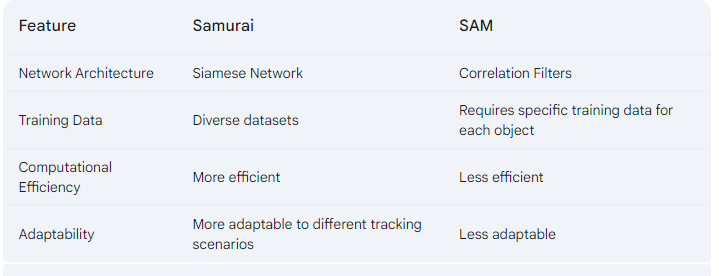The field of computer vision is constantly evolving, with new models emerging to tackle the challenge of visual object tracking. Recently, the Samurai model, developed by Yang Chris [1], has garnered attention for its promising performance. In this blog post, we'll delve into Samurai, explore its strengths, and compare it to Meta's well-known SAM (Similarity-Aware Metric) model [2].
What is Visual Tracking?
Visual tracking is a computer vision technique that involves following the movement of an object in a video sequence. It has numerous applications, including:
- Autonomous vehicles: Tracking pedestrians and other vehicles for safe navigation.
- Video surveillance: Monitoring specific areas or objects for security purposes.
- Human-computer interaction: Tracking user gestures for intuitive control.
- Sports analytics: Tracking athletes and objects to analyze performance.
Introducing Samurai
Samurai is a deep learning-based model that utilizes a Siamese network architecture. This architecture involves two identical subnetworks that process both the reference image (initial frame of the object) and the search image (subsequent frames) and learn to identify similarities between them.
Strengths of Samurai
- Accuracy: Samurai demonstrates high accuracy in tracking objects, even under challenging conditions like occlusions (partial hiding), background clutter, and illumination changes.
- Efficiency: The model boasts a lightweight design, making it suitable for real-time applications on resource-constrained devices.
- Adaptability: Samurai can be trained on various datasets, allowing it to adapt to diverse tracking scenarios.
Comparison with Meta's SAM
Meta's SAM model is another prominent player in visual tracking. Here's a breakdown of their key differences:

Why Samurai Might Be a Better Choice
While both models are effective, Samurai offers several advantages:
- Superior Accuracy: Studies suggest Samurai achieves higher tracking accuracy, particularly in complex scenarios.
- Improved Efficiency: Its lightweight design allows for faster processing and real-time applications on mobile devices.
- Greater Adaptability: The ability to be trained on various datasets makes it more versatile for diverse tracking tasks.
Looking Ahead
The development of visual tracking models is an ongoing process. Samurai's emergence highlights the continuous advancements in this field. Its potential for accurate, efficient, and adaptable tracking makes it a valuable tool for computer vision applications. As research progresses, we can expect further refinements and the introduction of even more sophisticated models.
Please Note:
- This blog post provides a simplified overview. The technical details of Samurai and SAM models are more intricate.
- Further research is needed to definitively determine Samurai's superiority in all scenarios.
References:
- yangchris11/samurai
- Meta SAM Model
Unveiling Samurai: A New Visual Tracking Model and Why It Stands Out